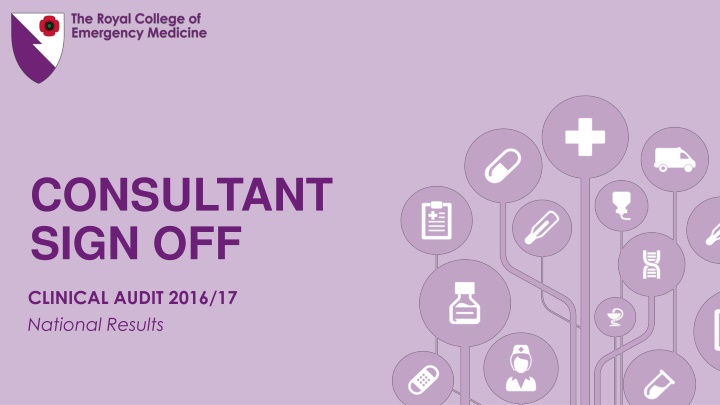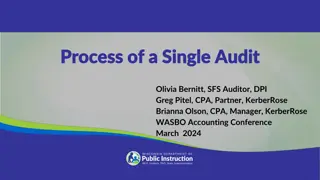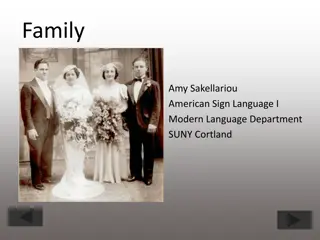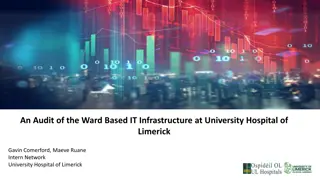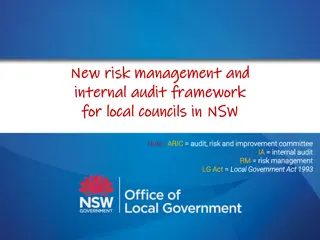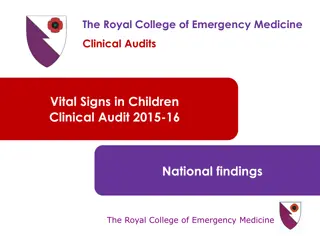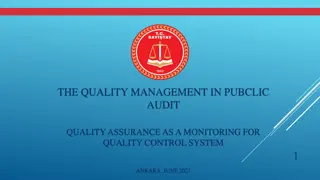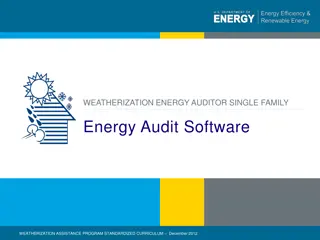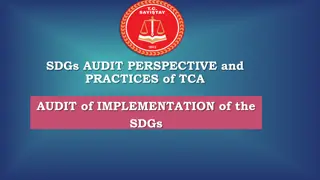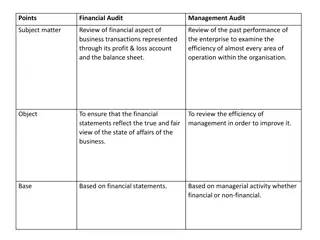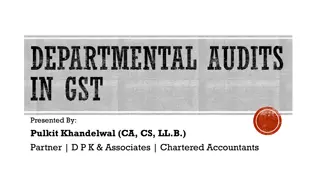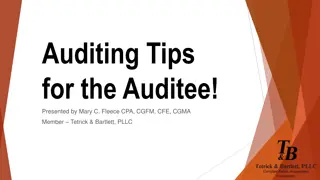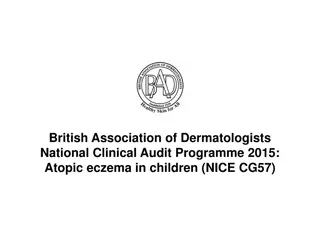National Clinical Audit 2016/17: Consultant Sign-Off Summary
This presentation displays the national results of the 2016/17 clinical audit, focusing on the performance of Emergency Departments (EDs) against audit standards. The audit objectives include benchmarking current performance, allowing national and peer comparisons, identifying areas for improvement, and comparing against previous years. High-risk patient groups that should be reviewed by a consultant in EM prior to discharge from the ED are outlined, along with definitions of terms used in the audit. The performance summary graph illustrates national compliance with standards. Detailed national findings for 2016/17, including percentages and quartiles, are provided for specific patient groups.
Download Presentation

Please find below an Image/Link to download the presentation.
The content on the website is provided AS IS for your information and personal use only. It may not be sold, licensed, or shared on other websites without obtaining consent from the author.If you encounter any issues during the download, it is possible that the publisher has removed the file from their server.
You are allowed to download the files provided on this website for personal or commercial use, subject to the condition that they are used lawfully. All files are the property of their respective owners.
The content on the website is provided AS IS for your information and personal use only. It may not be sold, licensed, or shared on other websites without obtaining consent from the author.
E N D
Presentation Transcript
CONSULTANT SIGN OFF CLINICAL AUDIT 2016/17 National Results
Contents This presentation shows how EDs are performing against the audit standards. For further information please see the national report at www.rcem.ac.uk/audits.
Audit objectives 1. To benchmark current performance in EDs against the standards. 2. To allow comparison nationally and between peers. 3. To identify areas in need of improvement. 4. To compare against previous performance in 2011/12 and 2012/13.
Standards Standard Standard type The following four high-risk patient groups should be reviewed by a consultant* in EM prior to discharge from the ED (includes patients who die in the ED). *The term consultant includes both consultants and associate specialists. Atraumatic chest pain in patients aged 30 years and over Developmental Fever in children under 1 year of age Developmental Patients making an unscheduled return to the ED with the same condition within 72 hours of discharge Fundamental Abdominal pain in patients aged 70 years and over Developmental
Definitions Standard Term Definition Discharge home ( or to the patient s usual place of residence) from the ED. Do not include patients discharged from another specialty. Include patients who die in the ED. All Discharge 2 Fever Temperature of > 38 C at triage/ED arrival, not prior to arrival or subsequently. 3 Unscheduled return Do not include patients who leave before being seen and then re-attend with 72 hours. 3 Unscheduled return Do not include patients who leave before being seen and then re-attend within 72 hours.
Performance Summary This graph shows the median national performance against standards for this audit. Higher scores (e.g. 100%) indicate higher compliance with the standards and better performance.
Summary of national findings National Results 2016/17 (24341 cases) RCEM Standard Median quartile quartile Upper Lower The following high-risk patient groups should be reviewed by a consultant in EM prior to discharge from the ED. *The term consultant includes both consultants and associate specialists. STANDARD 1: Consultant* reviewed Atraumatic chest pain in patients aged 30 years and over 100% 5% 11% 19% - Reviewed by ST4 or above 34% 43% 54%
Summary of national findings National Results 2016/17 (24341 cases) RCEM Standards LQ M UQ The following high-risk patient groups should be reviewed by a consultant in EM prior to discharge from the ED. *The term consultant includes both consultants and associate specialists. STANDARD 2: Consultant* reviewed Fever in children under 1 year of age. 100% 0% 8% 20% - Reviewed by ST4 or above 33% 48% 65%
Summary of national findings National Results RCEM Standards 2016/17 (24341 cases) LQ M UQ The following high-risk patient groups should be reviewed by a consultant in EM prior to discharge from the ED. *The term consultant includes both consultants and associate specialists. STANDARD 3: Consultant* reviewed Patients making an unscheduled return to the ED with the same condition within 72 hours of discharge 6% 100% 12% 24% 35% - Reviewed by ST4 or above 46% 60%
Summary of national findings National Results RCEM Standard 2016/17 (24341 cases) LQ M UQ The following high-risk patient groups should be reviewed by a consultant in EM prior to discharge from the ED. *The term consultant includes both consultants and associate specialists. STANDARD 4: Consultant* reviewed Abdominal pain in patients aged 70 years and over 100% 4% 10% 19% - Reviewed by ST4 or above 28% 40% 55%
Organisation audit and Casemix How do patients attending EDs compare nationally? What organisation features do EDs have? This section helps you understand more about the case mix and demographics of the patients.
On a weekday, assuming all shifts are filled, how many staff would usually be on each clinical shift? Sample: all EDs Chart shows the average number of consultants on shift was less than 2 at all times of the day and demonstrates the challenge of achieving the 4 standards.
On a weekend, assuming all shifts are filled, how many staff would usually be on each clinical shift? Sample: all EDs Chart shows the average number of staff per shift. Weekend staffing of EDs changes little for non-medical practitioners and Tier 1-3 doctors. There is however a noticeable reduction in the staffing rate for Tier 4 doctors and consultants. These more senior doctors may however work longer shifts at weekends to provide similar departmental cover with the aim of reducing the number of weekends worked.
Chart shows the average number of vacancies per level. Sample: all EDs This graph demonstrates the significant deficit in staffing for all groups except Tier 1 doctors. Section 4a of the full report demonstrates the extent to which departments rely on locums.
Historical chart showing how easy it is to collect data about consultant sign-off in your ED (Fully automated, straightforward, problematic and difficult). Sample: all EDs The chart demonstrates most departments had problems gathering data and that there has been little change since the last audit. The number of departments with a fully automated system has risen from 1% to 4% but remains small.
Casemix How do patients attending EDs compare nationally? This section helps you understand more about the casemix and demographics of the patients.
Day and time of arrival - Chest pain in patients over 30 years of age Sample: Q5 = atraumatic chest pain in patients aged 30 years and over The day and arrival time followed a similar pattern throughout the days of the week with only a modest reduction in activity at weekends. Attendances were distributed throughout the day with significant numbers of patients arriving overnight.
Day and time of arrival Fever in children under 1 years of age Sample: Q5 = fever in children under 1 year of age The attendances for febrile children showed an even distribution throughout the week. There were significant peaks in attendances in the evening from 6pm. Emergency department staff will be familiar with this observation but these results will continue to be useful for the planning of paediatric care and timing of senior cover.
Day and time of arrival Unscheduled return within 72 hours Sample: Q5 = Patients making an unscheduled return to the ED with the same condition within 72 hours of discharge It is perhaps not surprising to see a peak in unscheduled returns during the late morning on a Monday. The re- attendance rate was however distributed throughout the week and continued at all hours of the day.
Day and time of arrival Abdominal pain in patients aged over 70 Sample: Q5 = Abdominal pain in patients aged 70 years and over Elderly patients with abdominal pain presented at all times of day and throughout the week. The peak during late morning on Sundays is interesting to note. Perhaps more than for the other standards, this graph demonstrates the need for service and resource provision during all hours of the day, on all days of the week.
Patient Group Sample: all patients Chest pain was previously in patients aged 17+, this year it is 30+. Respondents to the audit were not required to submit an equal number of cases for each standard. This graph demonstrates that whilst cases of chest pain make up the majority, all 4 groups are significantly represented. It is encouraging that cases of abdominal pain in the elderly were well represented having been introduced as a new standard in 2016.
Patient outcome Sample: all patients Definitions: Day: 09:00-17:00 Evening: 17:01-00:00 Night: 00:01-08:59 Bank holidays: counted as Sat-Sun The audit excluded admitted patients. It was expected that most patients would be discharged from ED. It is surprising that the disposition of 7-8% of patients is not known and this is likely another indicator of the difficulty in obtaining data for the audit.
Audit results How did EDs perform against the standards? This section helps you understand more about how EDs performed nationally.
Patient outcome The following four high-risk patient groups should be reviewed by a consultant in EM prior to discharge from the ED (includes patients who die in the ED). Standard 1: Atraumatic chest pain in patients aged 30 years and over Standard 2: Fever in children under 1 year of age Standard 3: Patients making an unscheduled return to the ED with the same condition within 72 hours of discharge QIP Standard 4: Abdominal pain in patients aged 70 years and over *The term consultant includes both consultants and associate specialists
Proportion of patients in each high risk group that were seen and assessed by senior staff. There has been little change in the rate of senior assessment over the last 5 years. It should be appreciated that an additional standard was added in 2016 and that over this period ED attendances have continued to rise. The total number of patients assessed by senior staff has increased but the proportion of patients assessed by junior staff remains high. Measures to ensure senior discussion or subsequent case note review are vital and the further findings of this report will aid departments in assessing current performance and improving practice. UK Totals (Mean) % of those seen and assessed by: 2016/17 2012/13 2011/12 Consultant 12% 10% 10% Associate Specialist 2% 2% 2% Staff grade/specialist 14% 12% 14% Senior clinical fellow (register or equivalent) 6% 8% 4% ST4 to 7 9% 9% 12% Total 43% 41% 42%
Seen and assessed by a consultant Sample: Q5 = atraumatic chest pain in patients aged 30 years and over Standard 1: Atraumatic chest pain in patients aged 30 years and over should be reviewed by a consultant in EM prior to discharge from the ED (includes patients who die in the ED).
Seen and assessed by a consultant Sample: Q5 = fever in children under 1 year of age Standard 2: Fever in children under 1 year of age should be reviewed by a consultant in EM prior to discharge from the ED (includes patients who die in the ED).
Seen and assessed by a consultant Sample: Q5 = Patients making an unscheduled return to the ED with the same condition within 72 hours of discharge Standard 3: Patients making an unscheduled return to the ED with the same condition within 72 hours of discharge should be reviewed by a consultant in EM prior to discharge from the ED (includes patients who die in the ED). QIP
Seen and assessed by a consultant Sample: Q5 = Abdominal pain in patients aged 70 years and over Standard 4: Abdominal pain in patients aged 70 years and over should be reviewed by a consultant in EM prior to discharge from the ED (includes patients who die in the ED).
Grade of most senior doctor to actually see and assess the patient in person Chest pain in patients over 30 Sample: Q5 = atraumatic chest pain in patients aged 30 years and over There was a higher consultant review rate during Monday to Friday and daytime hours. Evening and night time reviews remain challenging. A significant proportion of patients were only seen by a junior grade FY1 to ST3.
ContinuedWas this doctor a locum? Sample: Q5 = atraumatic chest pain in patients aged 30 years and over There can be increased risks when staff work in an unfamiliar workplace with unfamiliar systems and processes. Where induction, governance and supervision processes are well established, a review by a locum need not mean sub-optimal care.
Grade of most senior doctor to actually see and assess the patient in person Fever in children under 1.
Grade of most senior doctor to actually see and assess the patient in person Unscheduled return with 72 hours.
Grade of most senior doctor to actually see and assess the patient in person Abdominal pain in patients aged over 70.
Grade of most senior doctor with whom the patient was discussed during their visit to the ED for all patient groups Grade of most senior doctor with whom the patient was discussed during their visit to the ED Chest pain in patients over 30.
Grade of most senior doctor with whom the patient was discussed during their visit to the ED - Fever in children under 1 year.
Grade of most senior doctor with whom the patient was discussed during their visit to the ED Unscheduled return within 72 hours.
Grade of most senior doctor with whom the patient was discussed during their visit to the ED Abdominal pain in patients aged over 70.
Grade of most senior doctor to retrospectively review the patients case notes for all patient groups (Excludes all patients who had already been seen (Q7) by or discussed with (Q8) a consultant/associate specialist). Grade of most senior doctor to retrospectively review the patient s case notes Chest pain in patients over 30.
Grade of most senior doctor to retrospectively review the patient s case notes - Fever in children under 1 year.
Grade of most senior doctor to retrospectively review the patient s case notes Unscheduled return within 72 hours.
Grade of most senior doctor to retrospectively review the patient s case notes Abdominal pain in patients aged over 70.
Conclusions Clinical IT systems may not capture all care providers for a patient and consultants may be unable to document their reviews during pressured, crowded shifts. Despite some increase, only 4% of departments described their data collection as fully automated . The audit shows an average rate of consultant review of 14% across the 4 standards. This remains well short of the 3 developmental and 1 fundamental aim of 100%. The further findings of the report have demonstrated the extent to which departments are able to ameliorate the risk either by review by senior trainees or subsequent case note review. 81% of the 180 departments contributing did however report that they felt the standards have an effect on clinical management and 79% an effect on admission or discharge decisions. Despite the challenges in achieving consultant review, the results for ST4 and above show the majority of patients benefit from at least middle grade expertise. When including these staff, the average review rate was 43%. The standards are valued but the ability to deliver and demonstrate them remains a challenge. The current problems encountered by EDs and the state of consultant staffing and recruitment are likely significant impediments to higher performance. There was, therefore, an average of 57% of cases which were assessed only by junior staff. These were found throughout the hours of the day and the days of the week but were more frequent during the night. Given this and the problems of consultant staffing, departments may wish to pursue the value of retrospective case note review. The findings within section 9a suggest that not all have adopted this practice or where present it may be incomplete. There may also be a significant challenge for departments to evidence senior reviews. Significant numbers of departments reported some difficulty collecting data for the audit.
Recommendations High risk cases present to EDs throughout the week and at all times of day and night. Departments should consider how staffing and seniority are balanced not only to demand, but also to the requirement for senior staff to care for high risk conditions. The adoption and reliability of a subsequent case note review appears incomplete. Departments are encouraged to examine this process and consider dedicated consultant time for this. The RCEM service delivery group have useful resources for job planning and ensuring that the consultant workforce identifies key direct clinical care administrative tasks. Departments appear to have more reliable methods for identifying patients making unscheduled returns. RCEM encourages EDs to examine whether processes for this group can translate to a higher review rate for other high risk groups. RCEM notes the difficulty gathering data and the small proportion of departments with automated clinical systems. Evidencing senior reviews is important for a number of reasons including the need for clear documentation and communication and for medicolegal reasons. Departments are encouraged to review how a senior review is documented, whether in a clinical system or in paper case notes.
Next steps Read the full report at www.rcem.ac.uk/audits Action planning Rapid cycle Quality Improvement Contact other EDs for tips & solutions
